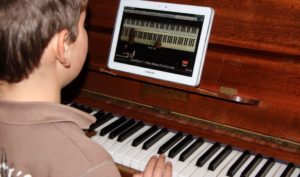
The best preschool piano book is the one that excites your child and engages them with the piano. It may not even be a "book." Many kids get their start by just sitting informally at the piano with a sympathetic adult and learning how to plunk out a familiar tune like Jingle Bells or Twinkle Twinkle,
Realistically, books only become involved with piano lessons when you want to start reading music. But reading music may not be the best platform for your child to start piano.
No need to print the book
if you use a tablet (see below.)
The reason that younger children have difficulty with reading music is that, often, their
brain hemispheres are not sufficiently connected. The connection between the brain hemispheres is called the Corpus Callosum, and is sometimes 40% larger in musicians.
The way around this is to delay the use of books, and to instead use the geography of the keyboard as the child's guiding light. Adopt a simple
visual approach that shows the child which keys to play for a specific familiar song, rather than insisting that the child get this information from the pages of a book.
The first visual guidance the child needs is to develop familiarity with the pattern of the keys, not the contents of boring books and memorize various arcane musical symbols. You must encourage the child to constantly LOOK at the keyboard, and absorb the pattern of 2 black keys and then 3 black keys that is the ordering principle of the piano (see below.)
If you do decide to start with reading music, here is what awaits you in the "standard" piano books from publishers like Faber, Bastien, Alfred and all the rest: they all do the same thing, and that is what bores children to tears.
First, they try the hand spread in a flat position, and you play the first five keys in a row (C, D, E, F, G or 1 2 3 4 5). Next they skip a note to check if you're really looking at the page (1 3 4 5). Third, they alter the pattern of five keys slightly, so the child gets used to looking at the page (1 3 2 3 4 5 ).
What's the problem with these books? THERE IS NO MUSIC. The act of making music has been reduced to deciphering century-old symbols that the child has never seen.
Alternatively, your first act as "teacher" is to get the child to enjoy a familiar song without the drudgery of reading music. Reading music comes later.
REFERENCES







